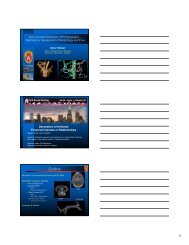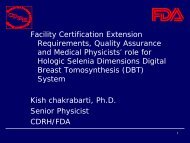InLight® nanoDot™ dosimeters from Landauer, Inc
InLight® nanoDot™ dosimeters from Landauer, Inc
InLight® nanoDot™ dosimeters from Landauer, Inc
Create successful ePaper yourself
Turn your PDF publications into a flip-book with our unique Google optimized e-Paper software.
Clinical Assessment and Utility of Eye Dose Measurements for Imaging Procedures<br />
Introduction: Recent reductions in the threshold of absorbed dose to the eye by the<br />
International Commission on Radiological Protection (ICRP) to 500 mGy indicate the<br />
need for elevated awareness of tissue reactions that lead to cataracts (1). Many Neuro CT<br />
scans, such as perfusion-CT and CT-angiography performed on stroke patients, have the<br />
potential of delivering high doses to the lens of the eye. Our goal was to design a process<br />
to clinically monitor eye dose during Neuro CT scans and use this process to assess the<br />
respective contributions to the total absorbed dose to the eye by the different components<br />
of stroke CT workups.<br />
Material and Methods: Eye entrance exposure measurements were made using InLight ®<br />
nanoDot <strong>dosimeters</strong> <strong>from</strong> <strong>Landauer</strong>, <strong>Inc</strong>. (Glenwood, IL). These nano-<strong>dosimeters</strong> use<br />
an optically stimulated luminescent (OSL) detector composed of carbon-doped aluminum<br />
oxide (Al2O3:C). The outside dimension of the<br />
dosimeter is 10x10x2 mm 3 . Their response is<br />
linear up to 3 Gy, with an energy range of 5 keV to<br />
20 MeV. The dose measurement accuracy of the<br />
<strong>dosimeters</strong> is +/-5.0%. These nano-<strong>dosimeters</strong><br />
have no angular or energy dependence making<br />
them ideal for both measuring doses to curved<br />
surfaces, such as the eye, as well as anatomy both<br />
in and out of the field. For all measurements,<br />
nano-<strong>dosimeters</strong> were taped on an in-house<br />
anthropomorphic head phantom either at the<br />
position of the eye lens or at the outside corner of<br />
the eye (Figure 1). The phantom was scanned<br />
using a typical stroke CT protocol. The first part<br />
of the study compared the total entrance exposure<br />
at the lens of the eye to that measured at the corner<br />
of the eye to verify similar exposures at these two<br />
locations, hopefully avoiding having to place the<br />
nano-<strong>dosimeters</strong> directly on the patient’s eye for<br />
clinical use. In the second part of the study, we<br />
separately evaluated three components used for a<br />
stroke CT workup: scout + non-contrast head,<br />
perfusion sequence, and CT-angiography (CTA) +<br />
post contrast head (Table 1). For each phase of the<br />
protocol, entrance exposure measurements were<br />
only made at the corner of the eye since little<br />
differences were observed during part 1 of the<br />
study.<br />
eye lens<br />
outside corner<br />
of eye<br />
Figure 1: Head phantom with nano<strong>dosimeters</strong><br />
placed at lens and corner of the<br />
eye.<br />
Table 1: CT stroke protocol<br />
Phase of<br />
CT Scan Details<br />
Protocol<br />
scouts, non-<br />
1<br />
contrast head<br />
2 perfusion (2 levels)<br />
3<br />
CTA, post contrast<br />
head<br />
Results: The results <strong>from</strong> parts 1 and 2 of the study are summarized in Figure 2. The<br />
total entrance exposure for the eye lens was 88 +/-5.9 mGy compared to 87 +/-3.8 mGy<br />
at the corner of the eye. The measured entrance doses for the 1 st , 2 nd , and 3 rd phases of<br />
the protocol were 25 +/-0.2 mGy, 24 +/-1.8 mGy, and 58 +/-2.4 mGy, respectively.
Clinical Assessment and Utility of Eye Dose Measurements for Imaging Procedures<br />
Entrance Dose (mGy)<br />
100<br />
90<br />
80<br />
70<br />
60<br />
50<br />
40<br />
30<br />
20<br />
10<br />
0<br />
eye lens: entire<br />
scan<br />
corner of eye:<br />
entire scan<br />
corner of eye:<br />
phase 1<br />
corner of eye:<br />
phase 2<br />
Figure 2: Eye entrance exposure measurements for part 1 (blue) and 2 (orange) of the study.<br />
corner of eye:<br />
phase 3<br />
Discussion: The results showed good agreement between the measured exposure to the<br />
eye lens and the corner of the eye indicating that the corner of the eye is a viable<br />
alternative to direct eye lens measurements. The CTA component of the stroke CT<br />
workup contributed more than half of the total eye dose delivered by the stroke CT<br />
protocol, while the non-contrast CT and the perfusion CT contributed equivalent, yet<br />
smaller doses. Although perfusion CT has been associated with alopecia (2), it appears<br />
that the CTA portion, for this particular protocol, could be adding similar risk for the eyes.<br />
Monitoring of cumulative eye dose for patients undergoing serial studies for stroke<br />
evaluation may aid in the planning of sub-threshold levels for cataracts when possible.<br />
References:<br />
1 ICRP ref 4825-3093-1464<br />
2 Y. Imanishi, A. Fukui, H. Niimi, et al., "Radiation-induced temporary hair loss as a<br />
radiation damage only occurring in patients who had the combination of MDCT and<br />
DSA," European Radiology 15-1 (2005).









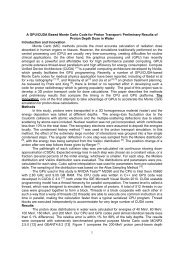
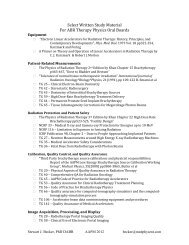
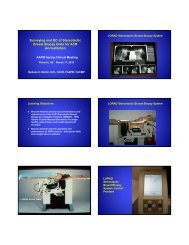
![SBRT&StereoscopicIGRT_2012 [Compatibility Mode]](https://img.yumpu.com/16889220/1/184x260/sbrtstereoscopicigrt-2012-compatibility-mode.jpg?quality=85)

